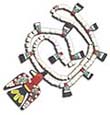You may not realize it, but some of the best antique jewelry wasn’t made with gold, diamonds, or pearls. Navajo and other Native American artists used silver, turquoise, coral, and other materials to create unique and intricate pieces.


Antique Native American jewelry makes a great investment and now is a great time to buy. A warning though that reproductions, which are less valuable than authentic jewelry, are common.
To increase your chances of finding authentic pieces, we suggest looking for natural stones and a good patina (the surface color formed from exposure to the air and human touch).
Here are some tips on the hottest styles of antique Native American jewelry:
Navajo ingot jewelry
Authentic ingot jewelry will be heavy and non adjustable. Look for indications that the piece was handmade, such as file marks and cracks inside and around any design. Most ingot jewelry was hand pounded from raw silver, and the absence of these marks indicates a machine-made piece.


The absence of a signature is not a red flag, however. Any signatures will be hand-etched — stamped signatures didn’t appear until the 1940s and 1950s.
Fred Harvey period jewelry
During the mid-1900s, Navajos sold handcrafted jewelry at trading posts along Route 66 and outside the railroad station in Albuquerque. Their business was aided by the Fred Harvey Company, which was instrumental in bringing tourists to the Southwest.


Look for plenty of stamping, repoussé, and appliquéd silver work on the rings, bracelets, and necklaces. Birds, arrows, and dogs were favorite forms of Fred Harvey period artists.
Santo Domingo necklaces
During the Depression, many Native American jewelry makers couldn’t afford traditional materials. Instead, they used whatever they could find to make “poor man’s squash blossom” necklaces. Old battery casings or 45 records became backings, while Bakelite, toothbrush handles, medicine bottles, and combs were transformed into decoration.


Zuni stone to stone jewelry
More colorful than other Native American jewelry, antique Zuni pieces are distinguished by dark red coral and greenish turquoise stones.
When buying Zuni jewelry, check the color of the stones. Varying hues of blue and green are an indication of natural turquoise. Over time, oxidation and the oil in human skin will change the color of stones. Greener turquoise is generally older.
However, if the turquoise is a consistent hue, you may be looking at stabilized stones, which are less valuable than natural turquoise. Stabilized stones have been injected with plastic to make them harder and brighter in color.
Native American jewelry is a diverse and culturally rich art form that has been created and worn by various Indigenous tribes across North America for centuries. These pieces often incorporate traditional materials and designs that are unique to each tribe and region. Some of the most common materials and styles in Native American jewelry include:
Silver has been a popular material for Native American jewelry, particularly among tribes in the southwestern United States. Navajo, Zuni, and Hopi artists are well-known for their intricate silverwork, including stamped designs, overlay techniques, and the use of turquoise and other gemstones.
Turquoise is one of the most iconic gemstones used in Native American jewelry. It is often used in combination with silver to create beautiful necklaces, bracelets, rings, and earrings. Different tribes have distinct styles and preferences when it comes to turquoise jewelry.
Many Native American tribes have a strong tradition of beadwork, creating intricate patterns and designs using small glass or metal beads. Beaded jewelry, such as necklaces, earrings, and bracelets, often reflects the tribal heritage and can include complex geometric or symbolic patterns.
Some tribes, like the coastal Native American communities, use seashells to create jewelry. Wampum, made from the purple and white shells of quahog clams, has been historically used for intricate beadwork and designs.
Heishi is a type of jewelry made from small disc-shaped beads, typically made from stones or shells. Tribes like the Santo Domingo Pueblo are known for their intricate heishi necklaces and other jewelry.
Inlay involves setting small pieces of stone, shell, or other materials into a pattern or design in a jewelry piece, such as rings, pendants, and bolo ties. Zuni artists are famous for their exceptional inlay work.
These are typically made by the Zuni tribe and feature small animal carvings, often from materials like turquoise, jet, or coral, strung together as a necklace. Each animal has specific symbolic meaning.
Some Native American tribes incorporate ancient petroglyph or petrograph designs into their jewelry, preserving and celebrating the art of their ancestors.
It’s essential to understand that Native American jewelry varies greatly based on the tribe, region, and individual artists’ styles and techniques. Each piece can carry cultural and spiritual significance, and it is often used for ceremonial purposes or as a form of personal expression.
When purchasing Native American jewelry, it’s essential to support authentic Indigenous artisans and verify the jewelry’s authenticity to respect the cultural significance of these pieces.
See our story: What to look for in collecting Native American Blankets
More Reading:
North American Indian Jewelry and Adornment by Lois Sherr Dubin
Native American Beadwork: Traditional Beading Techniques for the Modern-Day Beadworker
by Georg Barth, Bill Holm
Southwestern Indian Jewelry by Dexter Cirillo
Crow Indian Beadwork: A Descriptive and Historical Study by William Wildschut
The Turquoise Trail: Native American Jewelry and Culture of the Southwest by Carol Karasik, Jeffrey Jay Foxx
Hopi Silver: The History and Hallmarks of Hope Silversmithing by Margaret Nickelson Wright
The Complete Guide to Traditional Native American Beadwork:
A Definitive Study of Authentic Tools, Materials, Techniques, and Styles by Joel Monture, Larry McNeil
Zuni: A Village of Silversmiths by James Ostler
The Beauty of Navajo Jewelry by Theda Bassman, Gene Balzer
The Art of Native American Turquoise Jewelry by Ann Stalcup
Navajo Jewelry: A Legacy of Silver and Stone by Lois Essary Jacka, Jerry Jacka





